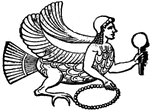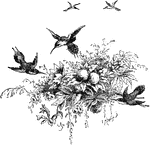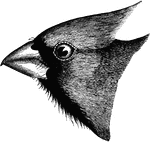
Cardinal Grosbeak
"Cardinalis virginianus. Cardinal Grosbeak. Cardinal Red-bird. Virginia Nightinggale. male, adult: Rich…
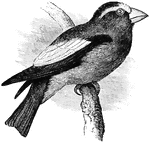
Evening Grosbeak
"Hesperophona vespertina. Evening Grosbeak. General color sordid yellow, overlaid with sooty-olive shade,…
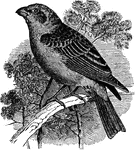
Pine Grosbeak
"Pinicola enucleator. Pine Grosbeak. Light carmine or rosy-red, feathers of back with dusky centres;…
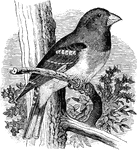
Rose-breasted Song Grosbeak
"Zamelodia ludoviciana. Rose-breasted Song Grosbeak. Adult male with the head and neck all around and…
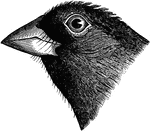
Blue Grosbeak Bill
"Guiraca. Blue Grosbeak. Bill Commissure strongly angulated far beyond base, with deep under mandible…
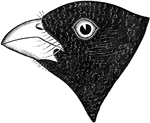
Song Grosbeak Bill
"Zamelodia. Song Grosbeak. Bill extremely heavy, with the lower mandible as deep as the upper or deeper,…

Ruffed Grouse Head
"Bonasa umbella. Ruffed Grouse. "Partridge;" "Pheasant;" Above, variegate reddish- or grayish-brown,…
The Pelvis of a Young Grouse
"Pelvis of a young grouse, showing three distinct bones. Il,P, ilium, ischium, pubis. In front of former…

The Wing Bones of a Young Grouse
"Fig. 29., from a young grouse (Centrocercus urophasianus, six months old), is designed to show the…

Canada Grouse
"Canace canadensis. Canada Grouse. Spotted Grouse. Spruce Grouse. Spruce "Partridge." Adult: Head smooth,…
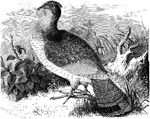
Ruffed Grouse
"Bonasa umbella. Ruffed Grouse. "Partridge;" "Pheasant;" Above, variegate reddish- or grayish-brown,…
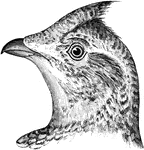
Sharp-tailed Grouse
"Pediaecetes phasianellus Columbianus. Common Sharp-tailed Grouse. Upper parts closely and pretty evenly…

Californian Guillemot Bill
"Bill averaging somewhat longer, about 1.90; culmen, commissure, and gonys nearly straight; upper mandible…

Common Guillemot Bill
"Bill black; bill along culmen 1.75; gape 2.50; gonys 1.15; depth at base .55; width .30." Elliot Coues,…

Pigeon Guillemot Bill
"Uria columba. Pigeon Guillemot. Bill stouter than that of grylle, and more obtuse." Elliot Coues, 1884

Sooty Guillemot Bill
"Bill larger than Pigeon Guillemot, 1.5-1.70 along culmen, along gape 2.20, from feathers on side of…

Thick-billed Guillemot Bill
"Lomvia arra. Thick-billed Guillemot. Arrie. Bill short, stout, wide, deep; culmen curved throughout;…

Common Guillemot
"Lomvia troile. Common Guillemot, or Murre. Adult in summer: Head and neck all around rich dark maroon…

Black Guillemot Bill
"Uria grylle. Black Guillemots. Bill much shorter than head, about equal to tarsus, straight, rather…

Bustard Gular Pouch
"Gular pouch of bustard; a, tongue; b, the pouch, opening under a, hanging in front of c, the trachea,…

Gull Bill
The bill of the gull (Laridae) is epignathous: "hook-billed; having the end of the upper mandible decurved…

Laughing Gull Bill
"Chroicocephalus atricilla. Laughing Gull. Black-headed Gull. Bill longer than middle toe and claw,…

White-headed Gull Head
"Larus heermanni. White-headed Gull. Bill shorter than head or tarsus, rather slender, moderately compressed,…

Harrier Ear Parts
"Circinae. Harriers. Face surrounded with an incomplete ruff (as in most owls); orifice of ear about…
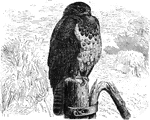
European Hawk
"Buteo vulgaris. hawk of Europe, Upper parts dark brown, very variable in shade according to season…
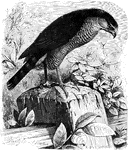
Sharp-shinned Hawk
"Accipiter fuscus. Sharp-shinned Hawk. "Pigeon" Hawk. Above, dark plumbeous, slate-color, or bluish-gray,…
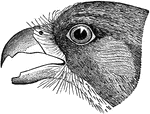
Sparrow Hawk
"Falco sparverius. Rusty-crowned Falcon. Sparrow Hawk. Adults: Crown ashy-blue, with a chestnut patch,…
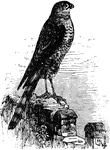
Sharp-shinned Hawk - Small
"Accipiter fuscus. Sharp-shinned Hawk. "Pigeon" Hawk. Above, dark plumbeous, slate-color, or bluish-gray,…
The Foot of a Prairie Hen
"Cupidonia. Tarsi scant-feathered to the toes in front and on sides, bare on a strip behind; toes extensively…
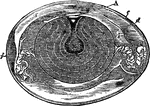
Hen's Egg
" Fig 110 - Hens egg, nat. size, in section; from Owen, after A. Thompson. A, cicatricle or "tread,"…
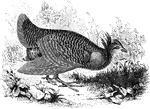
Prairie Hen
"Cupidonia cupido. Pinnated Grouse. Prairie Hen. Above, variegated with black, brown, tawny, or ochrey,…
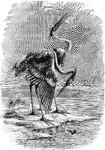
Heron
"Ardea. Great Herons. Of largest size, former well feathered all around. Tibia extensively denuded below.…

The Pelvis of a Heron
"Pelvis of a heron (ardea herodias), nat. size, viewed from below; from nature by Dr. R.W. Shufeldt,…
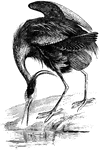
Great Blue Heron
"Ardea herodias. Great Blue Heron. Of large size, and varied dark colors, not dichromatic. Back without…
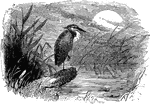
Night Heron
"Nyctiardea grisea naevia. Black-crowned Night Heron. Qua-bird. Squawk. Crown, scapulars and interscapulars…
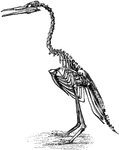
Restoration of Hesperornis regalis
"Hesperornis regalis, (a fossilized restoration) which stood about three feet high, had blunt teeth…
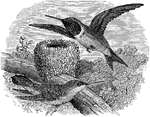
Ruby-throated Humming-bird
"Trochilus colubris. Ruby-throated Humming-bird. Tail forked, its feathers all narrow and pointed; no…

The Hyoid-bone of a Rook
"Hyoid bone; a, glosso-hyal, tipped with cartilage, its posterior horn being certo-hyals proper; b,…
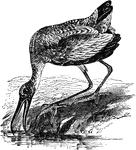
Wood Ibis
"Tantalops loculator. American Wood Stork. Wood Ibis. Colorado Turkey. Plumage white, the wing-quills,…
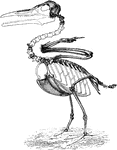
Restoration of Ichthyornis
"Ichthyornis, though the wings are well developed, with fused metacarpals, and the sternum is keeled,…
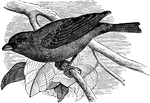
Indigo-bird
"Passerina cyanea. Indigo Painted Finch. Indigo-bird. Adult male: Indigo-blue, intense and constant…
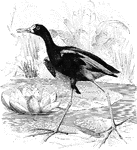
Parra Jacana
"Parra. Jacanas. Bill plover-like, contracted in continuity, enlarged terminally; with culmen depressed…
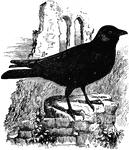
jackdaw
"Corvus monedul. Jackdaw. The species throughout uniform lustrous black, including the bill and feet;…
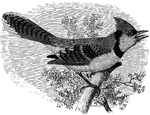
Blue Jay
"Cyanocitta cristata. Blue Jay. Male: Purplish-blue, below pale purplish-gray, whitening on throat,…

Canada Jay
"Perisoreus canadensis. Canada Jay. Whiskey Jack. Moose-bird. Gray whitening on head, neck, and breast;…
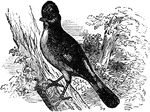
Eurasian Jay
"European Jay. Garrulus glandarius. With the wings much shorter than or about equalling the tail, both…

Long-crested Jay
"Cyanocitta stelleri macrolopha. Long-crested Jay. Upper parts sooty umber-brown, with a faint blue…

Common Kestral
Falco tinnunculus. Common Kestral. This bird is a European bird of prey. Plumage on upperside, chestnut-brown…
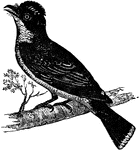
King-bird
Tyrannus carolinensis. King-bird. Bee-martin. No olive nor decided yellow. Only outer primaries obviously…
A Feather from the Tail of a Kingbird
"Fig. 23 - A feather from the tail of a kingbird, Tyrannus carolinensis, almost entirely pennaceous;…

The foot of a Kingfisher
"Fig. 44- Syndactyle foot of a kingfisher. Thus a kingfisher shows what is called a syndactyle or syngnesious…
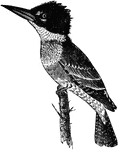
Belted Kingfisher
"Ceryle alcyon. Belted Kingfisher. Upper parts, broad pectoral bar, and sides under the wings, dull…
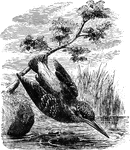
Common Kingfisher
Alcedo Ispida. European Kingfisher. Small bird, upper parts blue-green; under parts orange; rump and…
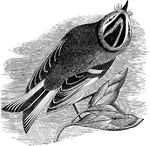
Golden Crested Kinglet
"Upper parts olive-green, more or less bright, sometimes rather olive-ashy, always brightest on the…
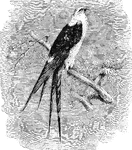
Swallow-tailed Kite
"Elanoides forficatus. Swallow-tailed Kite. Adult: Head, neck, band on rump, and entire under parts,…
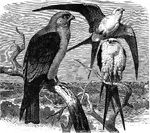
Two Swallow-tail and One Mississippi Kites
Two Swallow-tail and One Mississippi Kite. "Ictinia subcaerulea. Mississippi Kite. General plumage plumbeous…
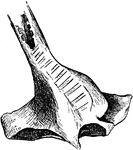
The Bony Labyrinth of a Sea Duck
"Bony labyrinth at the bottom of the trachea of the male Clangula islandica, seen from behind." Elliot…
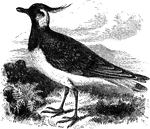
European Lapwing
"The glareoles (Glareolidae) are a remarkable Old World form, like long-legged swallows, wth a cuckoo's…
